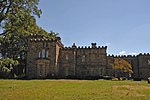Belle Meade, Virginia
Fauquier County, Virginia geography stubsUnincorporated communities in Fauquier County, VirginiaUnincorporated communities in VirginiaUse mdy dates from July 2023

Belle Meade is a small, unincorporated community in Fauquier County, Virginia, situated on State Route 55, and bypassed by Interstate 66. The hamlet is east of the Warren County line in the vicinity of Distillery Road. The Norfolk Southern Railway B-line runs through it, as well as being near the Appalachian Trail and the G Richard Thompson Wildlife Management Area. The term 'Belle Meade' is losing local use. Belle Meade is also the name of a small suburban community in Roanoke County, Southwest Virginia, with the zip code of 24018.
Excerpt from the Wikipedia article Belle Meade, Virginia (License: CC BY-SA 3.0, Authors, Images).Belle Meade, Virginia
Casanova Road,
Geographical coordinates (GPS) Address Nearby Places Show on map
Geographical coordinates (GPS)
| Latitude | Longitude |
|---|---|
| N 38.6575 ° | E -77.716944444444 ° |
Address
Casanova Road 5143
20187
Virginia, United States
Open on Google Maps





